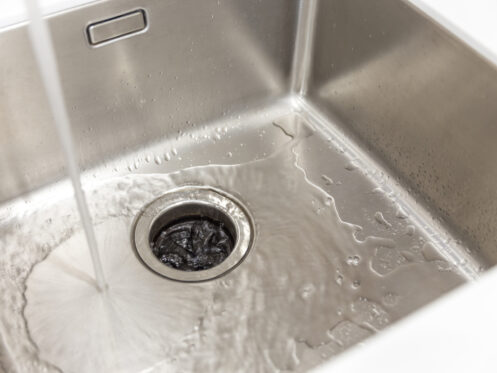Having a garbage disposal in your kitchen can come in quite handy. Unfortunately, garbage disposals can be fairly prone to a few different issues, especially when not used in the way they are intended to be. Luckily, most garbage disposal issues are fairly easy to fix as long as you know what to watch out for and what to do when a specific issue arises.
1. Garbage Disposal Is Jammed
The most common issue that garbage disposals experience is that they become jammed and stop working. Many people mistakenly believe that garbage disposals have sharp blades that chop up whatever you put into them, which isn’t the case. Instead, garbage disposals use centrifugal force to grind everything up so that it easily washes down the drain.
Inside a garbage disposal’s grinding chamber is a spinning disc known as an impeller plate that has two metal impellers or “teeth” on top of it. As the plate spins, the impellers force the food scraps against the shredding ring on the outer wall of the chamber, which grinds or pulverizes everything into tiny bits.
Garbage disposals are quite powerful. However, they aren’t designed to handle hard objects like bones, fruit pits, nut shells, etc. These items are too hard to be ground up easily, which is why they items should always go in the trash. The problem is that hard objects will often get trapped between one of the impellers and the side of the grinding chamber. When this happens, the disposal jams up, and the impeller plate can no longer spin. This is always an easy issue to spot as the garbage disposal will turn on and make a humming sound instead of the noise it normally makes.
On the underside of all garbage disposals is a small slot that fits a hex key or Allen wrench, and the purpose of this slot is so that you can manually turn the impeller plate and unjam it. Before trying to unjam the disposal, you should always make sure to unplug it just to be safe. You then need to insert the key or wrench that came with a disposal into the slot. You should then turn the wrench one full rotation in one direction and then a full rotation in the opposite direction. When you turn the wrench, the impeller plate spins and should free up whatever object was jamming it up.
After unjamming the disposal, it’s a good idea to use a flashlight and look inside it before plugging it back in and turning it on. If you can see whatever was jamming it up, you should use kitchen tongs to try and remove it. If you don’t take this step and there is something hard still inside the disposal, there is a high chance it will jam again. Some garbage disposals will automatically shut off if they get jammed. In this case, you will need to press the reset button on your disposal after unjamming it before it will run again.
If the disposal does jam again when you turn it back on, you may need to enlist the help of a plumber to unjam it and prevent it from happening again. What you absolutely shouldn’t do is let the disposal run for more than a few seconds if you hear that it is jammed. If you run the disposal when it is jammed, its motor will quickly start overheating and can easily end up burning out. Should this happen, you’ll then need to have your garbage disposal replaced.
2. Garbage Disposal Starts Leaking
Garbage disposals can also leak in various places, including where they connect to the sink or where they connect to the drain pipe. The drain hose from a dishwasher also connects to the garbage disposal and can start leaking as well. Fixing a leaky drain hose is usually as simple as tightening up the hose clamp or replacing the hose.
The sink flange that the disposal mounts to is prone to eventually leaking as it can slowly loosen due to the vibrations produced when the disposal runs. When this happens, you’ll see water leaking out from around the drain underneath the sink any time the water is running. This issue isn’t as easy to fix and is something you’ll want to hire a plumber to do.
The bolts that connect garbage disposals to the drain pipe can also loosen over time and lead to water leaking out from underneath the unit. However, a leak around the drain pipe more commonly happens because the rubber gasket that seals between the pipe and the disposal is worn out. In this situation, you’ll need to have a plumber disconnect the drain pipe and replace the gasket.
3. Garbage Disposal/Drain Pipe Is Clogged
Garbage disposals can be a major source of clogs when not used correctly. The drain at the bottom of the grinding chamber can easily clog and so can the drain pipe everything discharges out into. A garbage disposal will generally only ever clog because you tried to grind up food scraps that were too large or you put certain things into the disposal that you shouldn’t have.
Common sources of clogs include starchy foods like potatoes, pasta, rice and other grains. Fibrous fruits and vegetables like celery, pumpkins and other squash can also clog drains. Nuts and seeds should also never go in a garbage disposal since they will create a sticky paste that can stick inside the disposal or the drain pipe. Onion skins and eggshells should also always go in the trash and not down the garbage disposal. The issue here is that these things have slimy membranes that will often clog up the holes in the disposal where everything gets washed out.
4. Garbage Disposal Won’t Turn On
If your garbage disposal suddenly won’t turn on, it usually means that it has an electrical issue. In this situation, the first thing to do is check under the sink and make sure that the power cord hasn’t come loose. If the cord is still plugged in, you’ll then want to make sure that the circuit breaker isn’t tripped. After making sure that the disposal has power, the next thing to do is press the reset button.
The reset button on a garbage disposal is essentially a circuit breaker that shuts off the power to the unit to prevent its motor from burning out. The button will pop out and trip if there is too much electrical current flowing to the garbage disposal or it gets jammed. It can also happen because the unit has a damaged wire or its motor is wearing out. If you press the button and it pops back out, you should wait a few minutes and then try pressing it again. If the button keeps popping out and won’t stay latched, you’ll need to have a plumber inspect the unit to determine the specific issue.
If your garbage disposal is leaking or won’t work, you can count on the plumbers at Pipe Works Services for help. We’ve been providing expert plumbing repair and installation services throughout the Chatham area since 2000. We’re the one to trust for your heating, air conditioning, electrical and indoor air quality needs as well. To schedule an appointment for any home service, give our team a call today.





